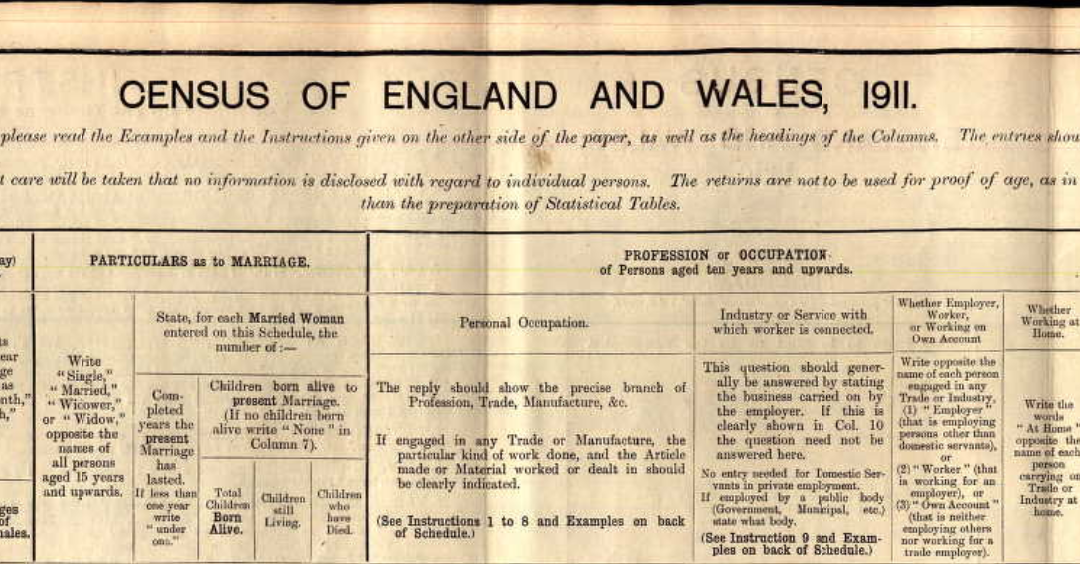By Nancy Rickman
Earlier in 2020, Nancy Rickman, a sixth-form History student from Guildford High School, undertook some work experience with the Victoria County History of Hampshire. What did she discover about the practice of historical research? And what did her census research and discoveries add to our understanding of a nineteenth-century Hampshire village? Here, Nancy shares her insights.
Over the summer, I was fortunate to have the chance to help the Hampshire Team of the Victoria County History Project with their work. I helped to transcribe the census data for the village of Popham for the years 1861-1911 and then had the opportunity to perform some preliminary analysis to look at how the village had changed through the second half of the century, and beyond the reign of Queen Victoria. I am studying A-Level History (along with English and Maths) and this was a brilliant chance to learn a little bit about what historians do, to discover how meticulous they have to be about data, and to discover a period of history that my A-level syllabus does not cover.
Popham is a small village in Hampshire, located between Basingstoke and Winchester, near the major A3 road from London to Portsmouth, and the railway. For most of the period I studied, Popham’s population hovered around 100-120 inhabitants. Interestingly, its layout and scale have not changed a great deal since the turn of the nineteenth century. Like many villages of the period, Popham was principally an agricultural settlement, with two large farms (plus an estate nearby), a church and a school.
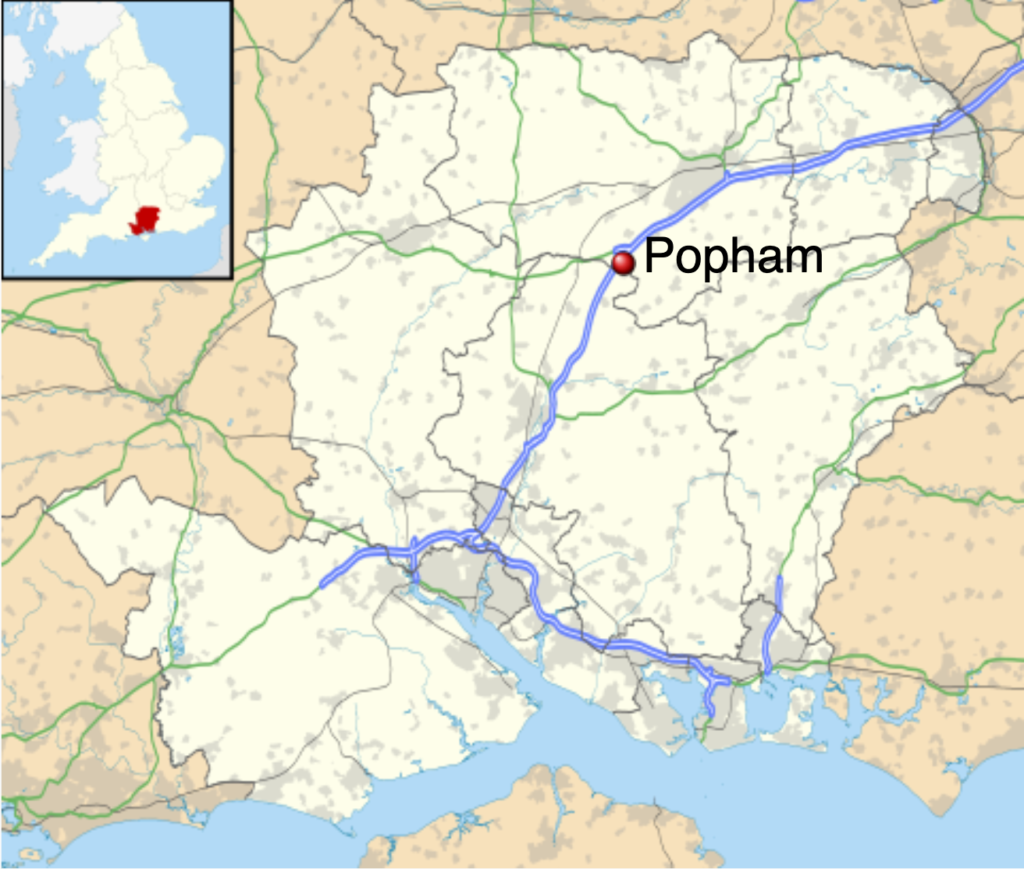
The period itself saw a lot of change for agriculture: more technology, competing job opportunities (and transport to reach them) following the industrial revolution and, at the heart of my data, economic hardship following the effects of the Corn Laws on agricultural prices. This could have seen the demise of small villages like Popham. However, the picture is more complex and the state of farming in Hampshire in the later eighteenth and early nineteenth century is much debated. While some authors suggest that many farms were too small to modernise, others argue that a new (Hampshire) breed of sheep, along with innovations like eight-crop rotation, allowed selected farms to develop a flexible approach and service niche markets that were becoming available towards London. Whether any of this could be seen in the census data from Popham was a really interesting question.
As already mentioned, the data themselves come from the decennial national population censuses that began in 1801. These are printed forms, completed by hand by a census recorder going door-to-door and are now available in PDF form. One part of the VCH’s many tasks is to transcribe these forms into spreadsheets for subsequent analysis. This was my principal role from which learned several important historical lessons. For example, Victorian hand-writing is not easy to read – perhaps the recorder’s resting on some sort of clipboard didn’t help! But the difficulties this raised, also gave me opportunities to try to find illegible names elsewhere to back up my ‘guesses’ and it was rewarding and exciting when this led me to discover other things about the villagers. For instance, discovering that one of the main famers had topped up an endowment bequest donated to the village for poor relief gave me an insight into his character and wealth. At the same time, however, this taught me that the census is quite basic, and that much of the information I sought would not be contained in this source.
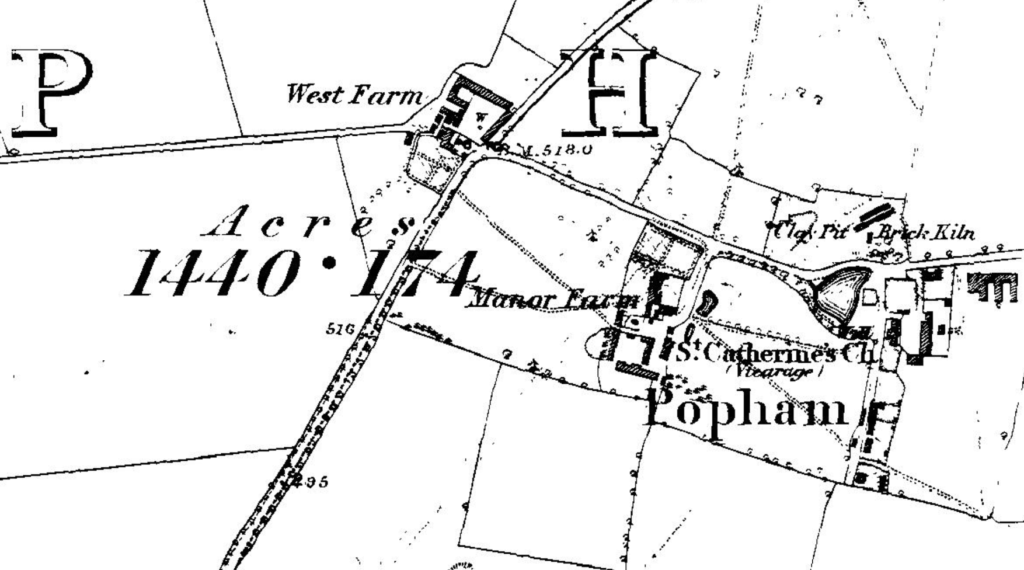
Popham, Ordnance Survey, 1876; ‘Sheet 025’, in Map of Hampshire (Southampton, 1866-1889), British History Online http://www.british-history.ac.uk/os-1-to-10560/hampshire/025 [accessed 18 December 2020].
Having completed the transcription, I had chance to look at the data. I was able to compare the composition of the village between 1861 and 1911, in terms of gender, age structure, household size and the place of birth of heads of household, along with the types of employment enjoyed by villagers and the ‘length of stay’ of households in the village. Although it’s not easy to judge decline from these data alone, I thought that if the village was getting smaller, or older, it might indicate that young families were leaving for better opportunities; or if jobs were changing it might mean that the traditional work villagers had relied on was drying up.
In fact, I found quite a lot of stability, though there were some interesting changes too. (It would be nice to have other villages to compare with.) As mentioned, the population fluctuated between roughly 100 and 120 throughout the period, with a reasonably even gender split and number of households (around 20-25) throughout. The age structure also remained fairly stable: the average age of Popham residents was between 25 and 27 years old and, when I computed the cumulative distributions of age for each census, they were all very similar. Interestingly, the number of heads of household born in Popham declined over the period, though the vast majority always hailed from Hampshire; this suggests increased mobility into the village, though not from afar. Similar evidence of mobility was shown by families’ lengths of stay in the village: while 7 of the 16 families present in 1861 were still resident in 1881, none of the 10 that arrived in 1881 remained in 1901. Nonetheless, a steady stream of arrivals kept numbers of families (and households) constant. Overall, there is not a lot of evidence of decline in Popham in the 60 years after 1861, indeed, perhaps the higher degree of mobility suggests an element of dynamism, possibly linked to improved transport links with nearby urban centres such as Winchester and Basingstoke.
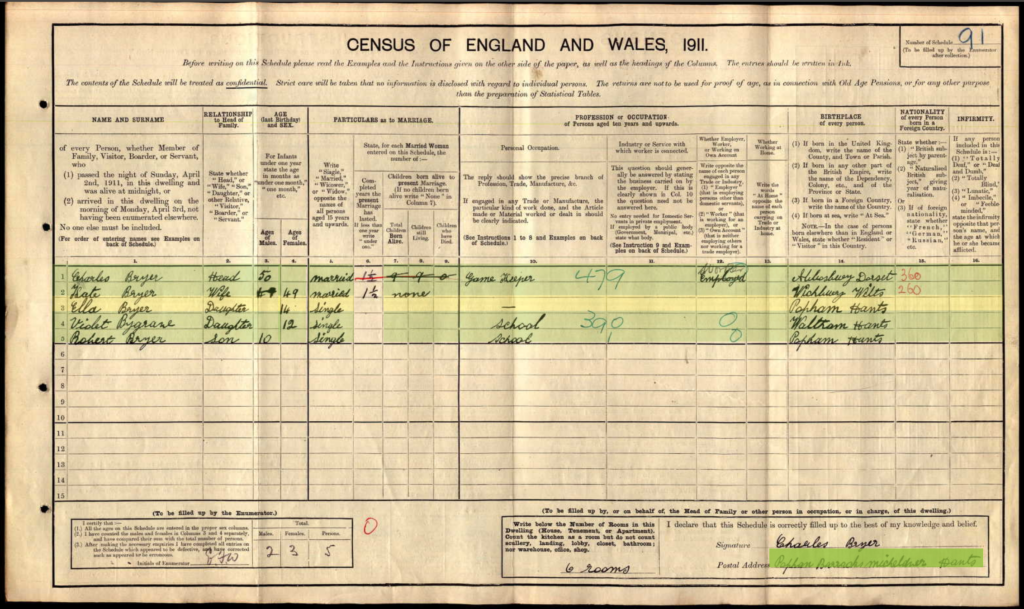
The 1911 census return for Ella Bryer, born in the hamlet and then aged 14. Her father Charles was a game keeper resident in Popham and originally from Dorset.
While I felt that population characteristics could say something about how Popham developed during the period, a number of the issues around agriculture at the time relate to labour. As the census records employment, it is possible to look at this as well. I created my own categories of ‘Farming/agriculture’, ‘Farmland/animal-related’, ‘Other labouring’, ‘Services’ and ‘Scholars’ (i.e. those attending the local school), so my results are shaped by these categories. In some cases, it was easy to categorise someone’s job (e.g. the curate, a governess, or a shepherd were straightforward); in other cases, things were harder (for example, was the single bricklayer in 1871 working on a farm or elsewhere?).
Nonetheless, there are interesting conclusions to draw from the census data. First, the variety of work grew over time. In 1861, I categorised the village into nine types of job (excluding scholars), but in 1881 there were 18 and by 1911, there were still 14 categories of employment. The reduction by 1911 can in part be explained by the disappearance of domestic servants who previously held roles as housekeepers, housemaids and dairymaids; this change might indicate a period of economic hardship or perhaps a growing tendency to internalise this work within the family.
Second, some of the variety seems to reflect economic developments: thus, the presence of a railway and road labourer are both suggestive of improved transport links (or perhaps the creation of new forms of employment), while the village housed a threshing machine operator and a traction engine driver in 1911. These are quite skilled roles in line with the growth of mechanisation.
Third, employment levels of Popham remained fairly stable; indeed, in 1861, 1891, 1901 and 1911 they were almost identical (about 40), while the returns for 1871 and 1881 saw higher numbers. Fourth, Popham seems to have remained a largely agricultural village, with around 50-70% of its workforce explicitly working on farms, or in farm / animal-related roles (woodmen, grooms, gamekeepers, among others). As well as weaknesses in my categories, the data may also have seasonal effects (as I do not know whether the census was taken in the Winter or the Summer) and there may be changes in categorisations by the census recorder (and the census itself): for example. there are seven ‘labourers’ in 1881, but none listed for other decades so I cannot tell whether this is an error, a single recorder’s opinion, or a change of recording policy. This means it’s difficult to make further comments on employment without more information. However, as with the data on the villagers, the evidence seems to suggest a degree of change, rather than any decline during the later parts of Victoria’s reign.
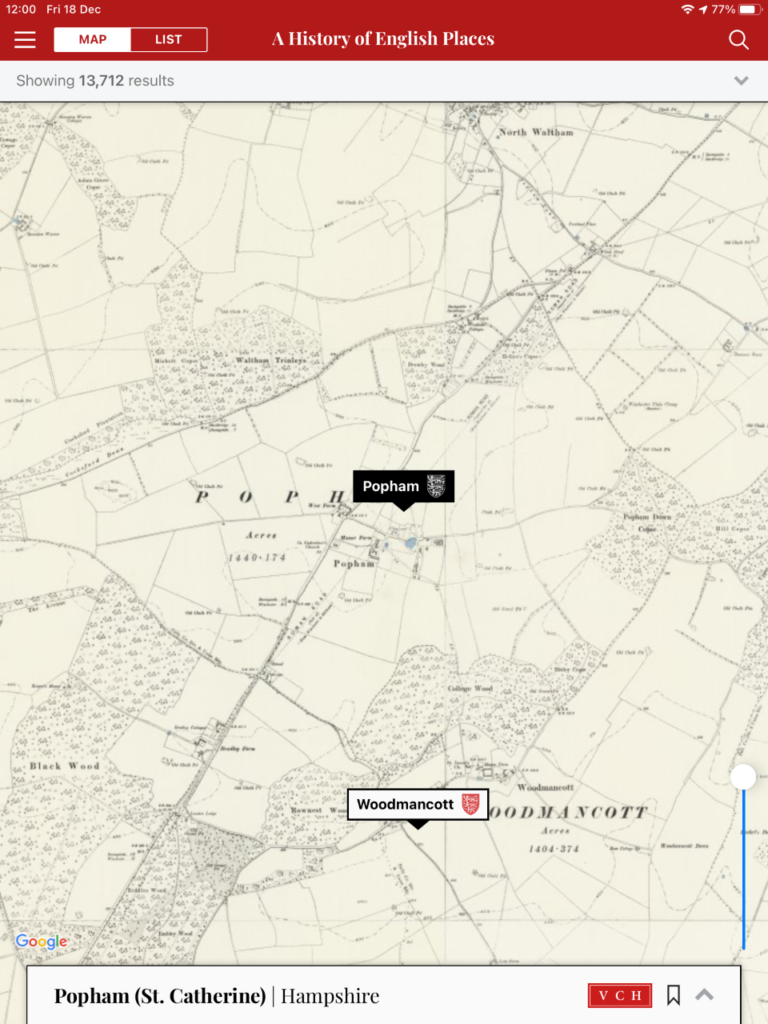
Popham as shown on the VCH app, ‘A History of English Places’
I really enjoyed looking at the data on Popham, and have been very lucky to have received so much help, and so many comments from the Hampshire Team of the VCH. It’s been great to have an insight into how much a historian has to take care of, and really ‘dig’ into, the data before it can be used, and it has been very exciting to know that nobody else has worked on exactly what I have studied for this purpose.
I was also surprised by how ‘involved’ I became with the village: really noticing when a family left after several decades, or when someone died, or returned having married. When I was working on the 1911 census, I couldn’t help wondering how some of the villagers might be affected by the First World War that was only three years away. This is something I would like to follow up on. I enjoyed the work so much that I have started to transcribe the census data for another village: Weston Patrick in Hampshire. Indeed, I already have one result: the recorder’s handwriting was even worse than that for Popham!
****

Acknowledgements
I would like to thank Professor Catherine Clarke, Director of the Victoria County History, and Dr Jean Morrin for helping to set up my work with the VCH in Hampshire, and would especially like to thank Jennie Butler for all her help and encouragement at every stage. The Hampshire team gave me some very helpful comments on my work, many of which I am very sorry not to have used so far: school tests, UCAS forms and coursework have taken over – but I can see that they would all make the work a lot better and I want to look into them as soon as I have the time.

